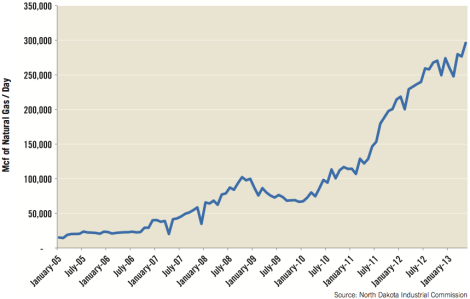
Tim EvansonGas flaring in North Dakota.
Amidst an oil and gas drilling boom in North Dakota, a new report suggests that nearly a third of the natural gas that’s being sucked out of the ground is being wasted — burned on site and flared away.
The practice of flaring — burning off natural gas instead of capturing and selling it — is so rampant in the state that it is clearly visible from space. Reuters reports:
Remote well locations, combined with historically low natural gas prices and the extensive time needed to develop pipeline networks, have fueled the controversial practice, commonly known as flaring. While oil can be stored in tanks indefinitely after drilling, natural gas must be immediately piped to a processing facility.
Flaring has tripled in the past three years, according to the report from Ceres, a nonprofit group that tracks environmental records of public companies.
“There’s a lot of shareholder value going up in flames due to flaring,” said Ryan Salmon, who wrote the report for Ceres. …
Roughly 29 percent of natural gas extracted in North Dakota was flared in May, down from an all-time high of 36 percent in September 2011. But the volume of natural gas produced has nearly tripled in that timeframe to about 900,000 million cubic feet per day, boosting flaring in the state to roughly 266,000 million cubic feet per day, according to North Dakota state and Ceres data.
Ceres estimates that the practice is costing shareholders $100 million a month in lost gas sales. Why would companies be willing to just burn away that potential revenue? Perhaps because the figure pales in comparison with the $2.2 billion they’re earning each month from crude oil production.
But forget about shareholder value. The flaring is polluting the air and the atmosphere without providing actual energy to anybody. If the natural gas is going to be extracted and burned, it might as well be put to some use.
Here’s a graph from the new report showing how much gas is being wasted in North Dakota:
Ceres warns that that the problem will continue to grow. From the new report [PDF]:
Ceres’ projections indicate that total flaring volumes will continue to rise above 2012 levels through 2020 unless the percentage of flaring is reduced from its current level to below 21 percent. Furthermore, even if the state’s goal of 10 percent flaring were achieved, total volumes of flared gas in 2020 would still exceed the amount flared in 2010.
Unfortunately, the most appealing solution for industry would be to lay more disaster-prone gas pipelines. Another option would be to build power plants closer to the gas fields. Of course, a third option, crazy though it may sound, would be to ease off from the whole oil and gas drilling thing.

Ceres




